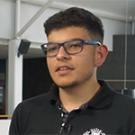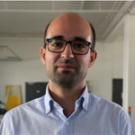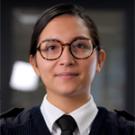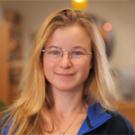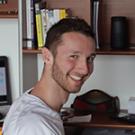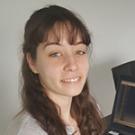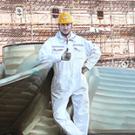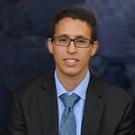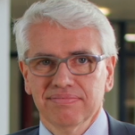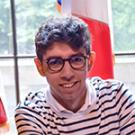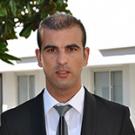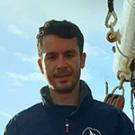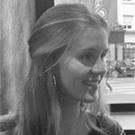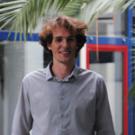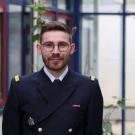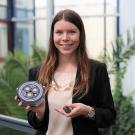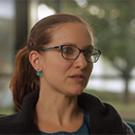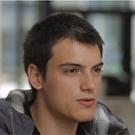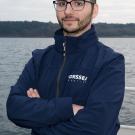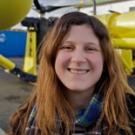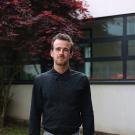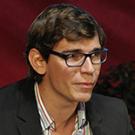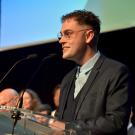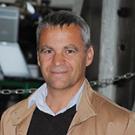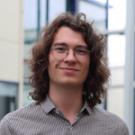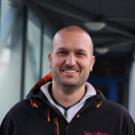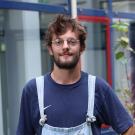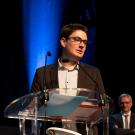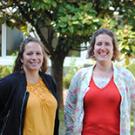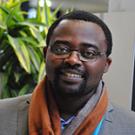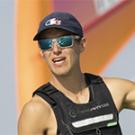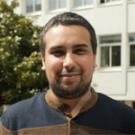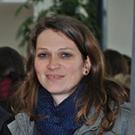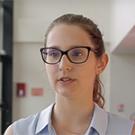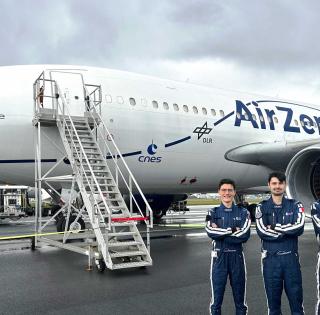
During her secondary school at the Louis-le-Grand and preparatory years at the Chaptal Lycées, she did high level Robotics
When she was in Year 12, she took part in the Olympiades des Sciences de l’Ingénieur with two friends and won the 2011 national finals, presenting their hexapod robot. This 6 legged robot (see photo below) imitated the movements of a hexapod: the legs moved in tripodal formation, 3 legs being in contact with the ground at a time during movement. This award motivated them to take the project further and present their robot at the 2012 C.Génial (1) competition, where they won first prize in the Engineering category and their qualification for the engineering category at the major international competition EUCYS. The trio won again and came back with the EIROforum special award, in September 2012 in Bratislava (Slovakia).
Ophélia was interviewed by the Conférences des Grandes Ecoles for the Grand Angle publication of November 2012.
« We are lucky to have meetings which are decisive for our project and to be supported by a coach without equal…Aiming for a scientific career, for both men and women, requires true curiosity, to go further, whilst having fun (…). The advantage of scientific studies today is that they open the gateway to a large number of fields, and also enable us to explore the technologies which make up our everyday lives, to explain the phenomena which surround us and to contribute to building tomorrow’s world “.
At ENSTA Bretagne, in her "diplôme d'ingénieur" (i.e. MSc in Eng.) program (2017 Cohort) Ophélia is exploring high technology and conducting several projects which are in line with her insatiable curiosity.
Within the framework of 2nd year applied projects, she is again involved in designing a robotic system which this time can be applied to the cleaning of the bottom of a silo for the Brest Chamber of Commerce and Industry (CCI). The pre-sizing of the device will result in a system composed of 3 modules: a rover motor which provides the propulsion, a front module, which enables loose matter to be removed and a rear module, which enables compacted matter to be removed (caked soya for example, central photo). At the same time, she and another ENSTA Bretagne student from Brazil on an exchange, are interested in a composite bio-material, based on wood fibers – called in French “lamibois” or English “Laminated Veneer Lumber” or “LVL”. Together, they wrote a scientific article on the subject that they submitted to the ACE-X 2016 scientific conference, and they were selected to participate in the conference in Croatia alongside numerous researchers and doctoral fellows.
At the same time, Ophélia enjoys a particularly full student life.
She was president of the riding club « Foy’zwoman » in the association which runs the students’ hall on campus, and member of the music club: she plays bass and performed at the February 2016 ENSTA Bretagne Gala with her group.
Ophélia : « The diversity of the clubs and sports associations is one of the strong points of ENSTA Bretagne. It enables us to have a balanced life, it is essential for personal development during our studies. I really appreciate that, here in the USA where the rhythm of lessons is particularly intense. We are also really lucky to be able to do a large number of sports and activities at ENSTA Bretagne for free or at a reduced price. For example sailing or horse riding: the school helps towards the cost of the lessons, training and events. For horse riding, I was able to organize weekends for advanced riders at the Saint-Cyr Coëtquidan stables, beginners weekends open to the whole school and a federal exam session. I also enjoyed being part of the Foy’z, at the heart of student life in the school. All of these experiences have been extremely enriching!”
A career path continuing abroad
The superb Brest Roadstead and its vast seascapes have given her a taste for further horizons. Ophélia has chosen to do her 3rd year engineer training at the American University of Illinois at Urbana-Champaign, 2 hours drive south of Chicago. With the precious support of the ENSTA Bretagne Mechanics and English teachers, she prepared her dossiers for the USA and obtained the Fulbright-Monohan scholarship (2) (class of 2017).
Before obtaining her master in December 2017, and following up with her thesis at the same university, Ophélia has set out on a new challenge and obtained her reward.
Ophélia : « At Urbana-Champaign, I am working in collaboration with biologists, researchers and other students within the Mechanics Department. As “lead graduate student” I get to work in all areas. On 29 June, in Paris, we took part in the finals of the BIO Minnovate Challenge, organized by the Centre Européen d'Excellence en Biomimétisme (CEEBIOS) at Senlis (European Center of Excellence in Biomimetics). I am returning to the USA with some good news for my team: we won 2nd prize in the BIOMinnovate Challenge!”
2nd prize at the BIOMinnovate Challenge 2017
Ophélia « We were inspired by a click beetle (it makes a very characteristic “click” when it jumps) to create a small robot capable of righting itself after a fall. The click beetle has developed a unique jumping technique: when it falls on its back, it uses its body to store up enough energy to propel it through the air to correct its orientation and fall on its feet. My team is made up of engineers from various disciplines and biologists. We are studying the jump mechanism on a microscopic (tribology) and macroscopic (dynamic) scale to model it then create prototypes to test our models. Our aim is to create a robust and reliable mechanism that can be used to make bio-inspired robots that are maneuverable and adaptable (they can move on uneven ground). The fields of application are agriculture, prospection of new planets or the exploration of dangerous or disaster areas looking for survivors”.










